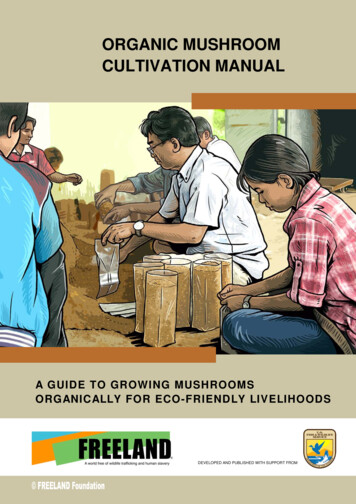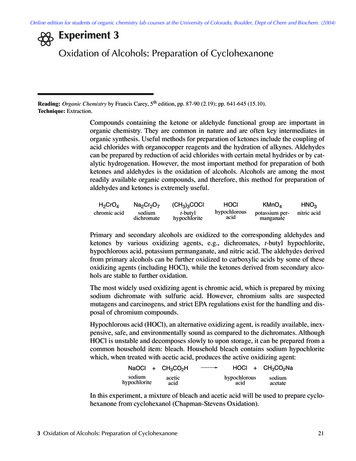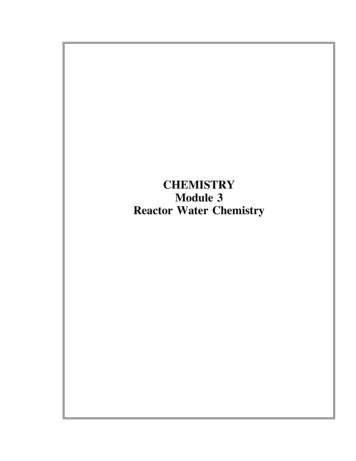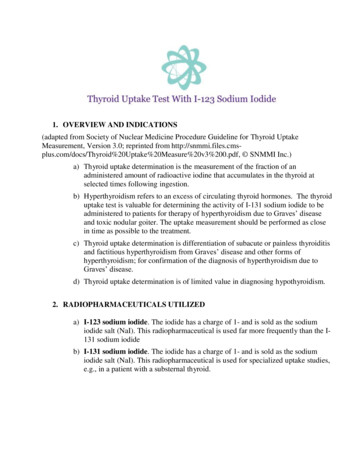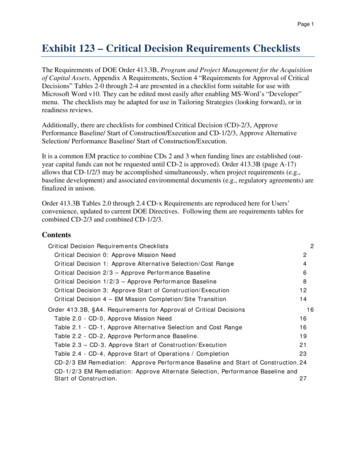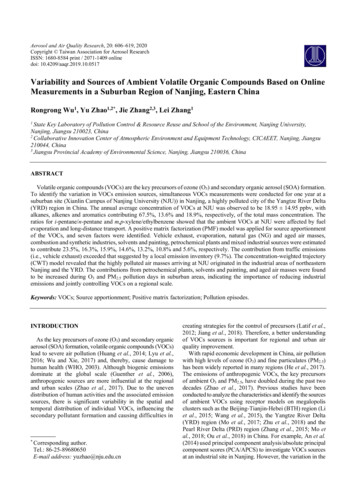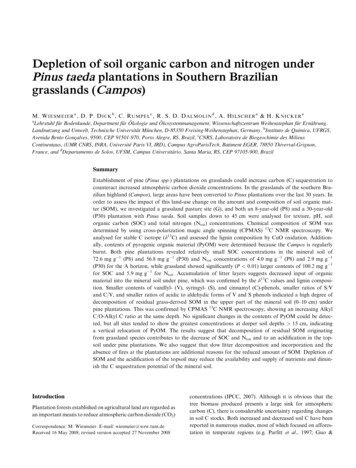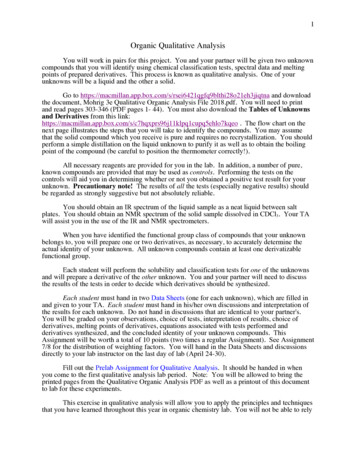
Transcription
Chemistry 123: Physical and Organic ChemistryPractice Exam 12009The exam will be composed of 3 sections. The first section will contain 30multiple choice marked at 1 point each. The second section will consist of 6 questions of 4 points each for 24 points. The third section willconsist of 8 questions of 6 points each.Section 1: Multiple Choice: (20 marks total) No samples provided,see quizzes and midterms for examples.Section 2: Short Answer (25 marks total)2.1) Name the following 4 compounds: [1 point each, 4 obut-1-ene2.2) Draw the following compounds in the box provided [1 point each, 4 total]a) 3-methylcyclopentanonePage 1 of 9
Chemistry 123: Physical and Organic ChemistryPractice Exam 12009b) 3-methylcyclopentanonec) 2,3-dimethylbutanoic acidd) N-tert-butylcyclohexanamine2.3a) Indicate which of the following would be the stronger acid and justify youranswer! [2 Marks]2-methylpropanoic acid compared to 3,3-dichloro-2-methylpropanoic acidPage 2 of 9
Chemistry 123: Physical and Organic ChemistryPractice Exam 120092.3b) Indicate which of the following would be the stronger base and justify youranswer! [2 Marks]1,1-dichloro-2-methylpropan-2-amine compared to 2-methylpropan-2-amine2.4) For the compounds below indicate How many 1º, 2º or 3º Carbons andHydrogens are present. Circle any Chiral centers. [5 Marks]OH3CH3CCH3H2 NOHOCH31º Carbons 1º Hydrogens2º Carbons 2º Hydrogens3º Carbons 3º HydrogensNH21º Carbons 1º Hydrogens2º Carbons 2º Hydrogens3º Carbons 3º Hydrogens2.5) For the compounds below indicate it’s conjugate acid or base and calculatethe appropriate Ka or Kb for that conjugate acid or base. [4 marks]Acid or baseHClO2Ka or Kb1.1 x 10pK-2Conjugate1.96ClO2Ka or Kb2.33 x 10-11C2H5NH23.74 CHO2HONH2pK-10.635.56 x 10-115.96Page 3 of 9
Chemistry 123: Physical and Organic ChemistryPractice Exam 120092.6) The following table indicates the relative rates of a series of NucleophilicSubstitution reactions. Explain the order of the relative rates (one sentence) andthen indicate if and how the order would change if the mechanism proceeded byan SN1 mechanism. [4 marks]Explaination:For a SN1 Mechanism :Page 4 of 9
Chemistry 123: Physical and Organic ChemistryPractice Exam 12009Section 3: Long Problems (55 marks total)3.1) If 24 g of ice at -5ºC is added to a isolated dewar containing 50 mL of waterat 10ºC. what would the temperature of the system be at equilibrium if the heatcapacity can be ignored and the system is completely isolated. [6 marks]3.2) If 0.3268 g of ethyl ketone (C4H8O) is completely combusted in a bombcalorimeter assembly with a heat capacity of 5.136 kJ/ºC and an initialtemperature of 22 ºC, what is the final temperature? [2 marks](ΔH combustion -2444 kJ/mol)Page 5 of 9
Chemistry 123: Physical and Organic ChemistryPractice Exam 120093.3) Consider the following reaction mechanism: What effect will the followinghave on the rate? [6 marks]a. addition of Br-b. using a stronger nucleophilec. using a more concentrated nucleophile3.4) Starting with the given Newman Projection and rotating the front carbonclockwise, predict (and draw !) the separate Newman Projections and the energyprofile diagram for the molecule shown: [ 5 marks]BrHHHHPotential EnergyBr0 60 120 180 Page 6 of 9240 300
Chemistry 123: Physical and Organic ChemistryPractice Exam 120093.5a) The decomposition of AB3 is first order with a k 1.5 x 10-5 s-1 at 25ºC. Ifthe initial concentration of AB3 is 0. 50 M, what is the concentration after 2 min?[3 marks]3.5b) What is the half-life for the reaction above?[2 marks]3.6a) Calculate how much Formic acid (HCHO2)(Ka 1.8 x 10-4) and it’s sodiumsalt to add to 500 mL volumetric flask in order to make a buffer of pH 4.75[3 marks]3.6b) If 10 mL of 0.01 M NaOH is added to 20 mL of the solution created in 3.6a,determine the pH and the concentration of Na . [2 marks]Page 7 of 9
Chemistry 123: Physical and Organic ChemistryPractice Exam 120093.7) Determine a) the order of each reactant, b) the order of the reaction, c) writethe rate law and d) calculate the rate constant, k, for the following data: [5marks]Reaction1.2.3.Order of A[A]0.20 M0.400.20[B]0.10 M0.100.20Order of BReaction OrderRate Lawk .rate3.50 x 10-37.00 x 10-37.00 x 10-3.3.8a) Determine the ΔHº for reaction #1 given the information provided; [3 marks]Reaction 1) C2H4 (g) Cl2 (g) C2H4Cl2 (l)ΔHº Reaction 2) 4HCl (g) 2Cl2 2H2O (l)ΔHº -202.4 kJReaction 3) 2HCl C2H4 (g) ½ O2 (g) C2H4Cl2 (l) H2O (l)ΔHº -318.7 kJ3.8b) If ΔfHº of C2H4 (g) is 52.26 kJ /mol, what is ΔfHº for C2H4Cl2 (l) ? [2 marks]Page 8 of 9
Chemistry 123: Physical and Organic ChemistryPractice Exam 120093.9) Consider the reaction;2 SO2 (g) O2 (g) 2 SO3 (g)Kp 90.8 @ 600ºCIf at some point the partial pressure of the gases SO2 , O2 and SO3 aremeasured as 0.518 atm, 1.65 atm and 5.62 atm. Is the system at equilibrium? Ifnot what direction would it be moving? Justify your answer by calculating ΔG.[6 marks]Page 9 of 9
Chemistry 123: Physical and Organic Chemistry Practice Exam 1 2009 Page 5 of 9 Section 3: Long Problems (55 marks total) 3.1) If 24 g of ice at -5ºC is added to a isolated dewar containing 50 mL of water at 10ºC. what would the temperature of the system be at equilibrium if the heat capacity can be ignored and the system is completely isolated.
